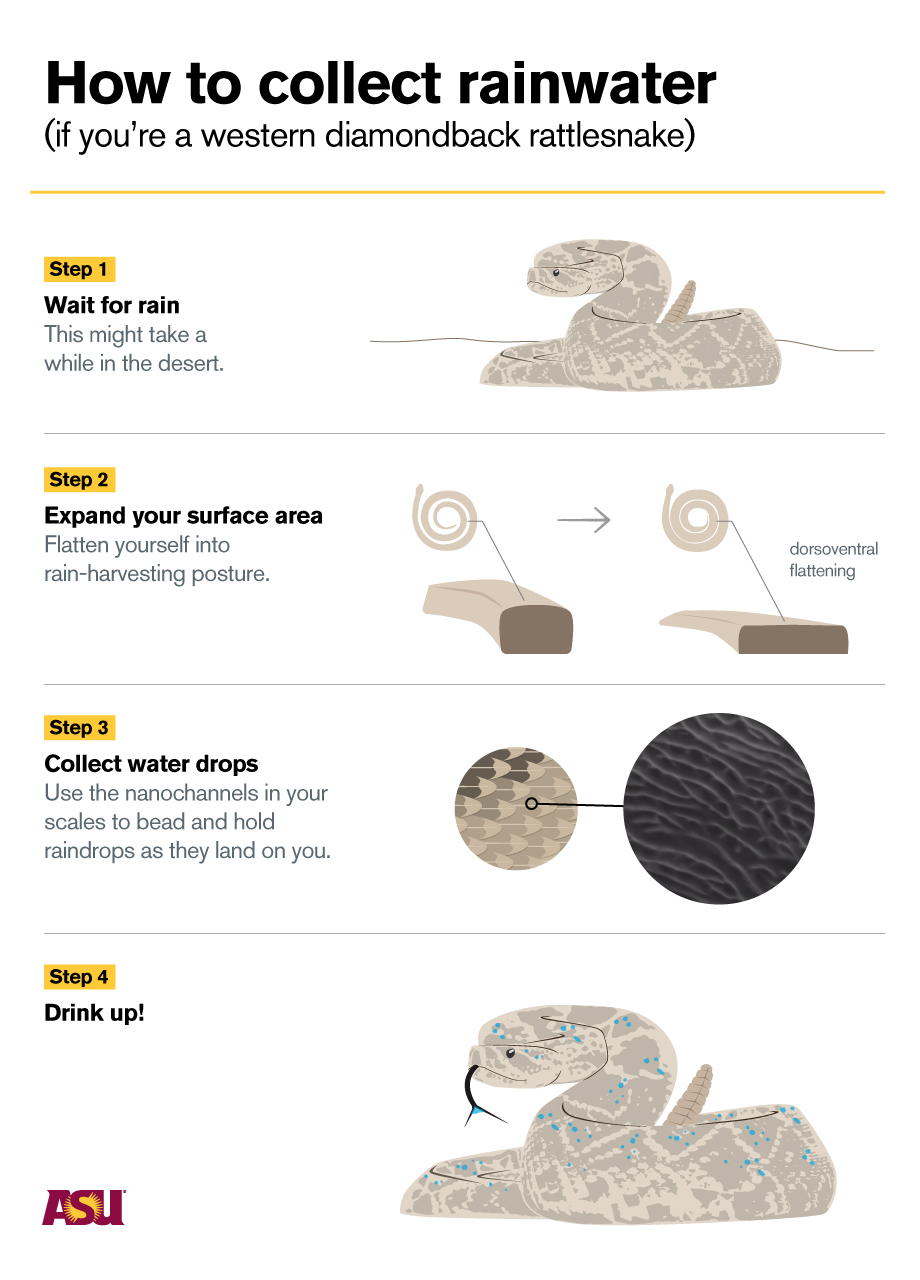Rattlesnakes and rain: A desert mystery
ASU engineer and evolutionary ecologist team up to solve slippery question

Summer monsoon rains have finally come to the Sonoran Desert. At first it’s a soft patter as rain drops raise puffs of dust, then the water comes quicker and quicker until it’s falling with the staccato of a typewriter on deadline.
A rattlesnake undulates from its den and coils on a rock. Its body flattens out. Rain drops stick to its body and slide down into channels in its skin. The snake turns its head around and begins drinking.
“They use their body as a bowl,” said Konrad Rykaczewski, an engineer at Arizona State University.
Water droplets stick to their scales. But why would the droplets stick? Nothing sticks to snakes.
That was the question Rykaczewski and evolutionary ecologist Gordon Schuett set out to answer. Their discovery was highlighted in a recently published paper, which they discussed Wednesday in a Nature@Noon talk at ASU’s Biomimicry Center.
The Biomimicry Center at ASU addresses a variety of sustainability challenges using methodologies inspired by natural systems through research, education and outreach activities. By asking the question, “How would nature do this?”, biomimics around the world are creating products, processes, companies and policies that are well adapted to life on Earth over the long haul. Examples include turbine blades designed like whale fins to reduce drag and stronger fiber optics produced like sea sponges.
Schuett, the science director at the Chiricahua Desert Museum, has studied diamondback rattlesnake behavior for 16 years. He has seen this behavior many times in the desert, including one winter where a large number of rattlers lay on a shelf outside a den drinking snow off their bodies. (They were radio-tracked. The chances of running into a sight like that by luck are slim to none.)
But how does it work?
“We’re interested in the fundamental physics of why this happens,” Rykaczewski said.
Other snakes have been observed drinking rain from their bodies, but rain harvesting by rattlesnakes equates to survival in the Southwestern deserts, where temperatures can hit 122 degrees Fahrenheit and months can pass without rain. Rattlers can go 200 days without water. When it does rain, they need to make the most of it.
“If they’re spending the winter in a shelter, where are they going to get water?” Schuett asked.
“Imagine standing in the rain and trying to collect enough water to survive,” Rykaczewski said. “Good luck.”
How does the texture of rattler skin contribute to rain harvesting? Rykaczewski bored down on the scales of adult western diamondback rattlers and, for comparison, those of desert kingsnakes and Sonoran gopher snakes. The two latter species don’t harvest rainwater.
Rattlesnake skins are rough and highly water-repellent. They have a high contact angle and a dense labyrinthlike nanotexture. Grooves and channels run down the scales. The texture slows water down and collects it.
“Here we have another perspective of why snakes shed frequently,” Schuett said. “It’s to keep the nanochannels as efficient as possible.”
The Biomimicry Center funded the study. The next Nature@Noon lecture will be held on March 25.
Top image by Alex Cabrera, Media Relations and Strategic Communications.
More Science and technology

Celebrating 34 years of space discovery with NASA
This year, NASA's Hubble Space Telescope (HST) is celebrating its 34th anniversary of the world's first space-based optical telescope, which paved the scientific pathway for NASA's James Webb Space…

Making magic happen: Engineering and designing theme parks
The themed entertainment industry is widespread and diverse, encompassing everything from theme parks to aquariums, zoos, water parks, museums and more. The Theme Park Engineering and Design…

AI-equipped feeders allow ASU Online students to study bird behavior remotely
ASU Online students are participating in a research opportunity that's for the birds — literally. Online Bird Buddies is a project that allows students to observe birds remotely, using bird feeders…
